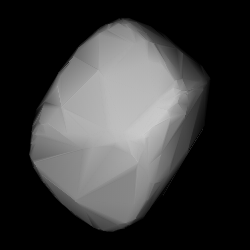 Shape model of Charlois from its lightcurve | |
| Discovery [1] | |
|---|---|
| Discovered by | A. Patry |
| Discovery site | Nice Obs. |
| Discovery date | 22 February 1939 |
| Designations | |
| (1510) Charlois | |
Named after | Auguste Charlois (astronomer) [2] |
| 1939 DC ·1959 WE 1963 UB | |
| main-belt · Eunomia [3] | |
| Orbital characteristics [1] | |
| Epoch 4 September 2017 (JD 2458000.5) | |
| Uncertainty parameter 0 | |
| Observation arc | 78.10 yr (28,525 days) |
| Aphelion | 3.0649 AU |
| Perihelion | 2.2791 AU |
| 2.6720 AU | |
| Eccentricity | 0.1470 |
| 4.37 yr (1,595 days) | |
| 16.619° | |
| 0° 13m 32.52s / day | |
| Inclination | 11.821° |
| 331.49° | |
| 165.25° | |
| Physical characteristics | |
| Dimensions | 20.30±0.39 km [4] 23.68 km (derived) [3] 23.80±2.8 km (IRAS:11) [5] 24.507±0.345 [6] 26.98±0.64 km [7] 27.608±0.373 km [8] |
| 5.866±0.0003 h [9] 6.653±0.008 h [10] | |
| 0.0769±0.0086 [8] 0.0791 (derived) [3] 0.081±0.004 [7] 0.1033±0.029(IRAS:11) [5] 0.118±0.017 [4] [6] | |
| SMASS = C [1] · C [3] [11] | |
| 11.2 [7] [8] ·11.40 [4] ·11.5 [1] [3] | |
1510 Charlois, provisional designation 1939 DC, is a carbonaceous Eunomia asteroid from the middle region of the asteroid belt, approximately 24 kilometers in diameter.
Contents
- Orbit and classification
- Physical characteristics
- Diameter and albedo
- Rotation period
- Naming
- References
- External links
It was discovered on 22 February 1939, by French astronomer André Patry at Nice Observatory in southeastern France, and later named after astronomer Auguste Charlois. [2] [12]